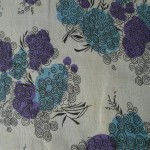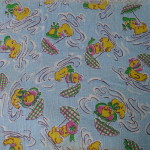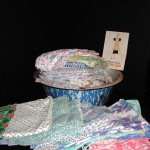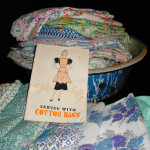Pine Mountain Settlement School
DANCING IN THE CABBAGE PATCH
Feed Sack and Fashion

“Sewing with Cotton Bags: Style Thrift,” says the sewing instruction booklet. The cloth was indeed thrifty, durable, and easy to handle, but it was limited in size. [feedsack_007.jpg]
DANCING IN THE CABBAGE PATCH Feed Sack and Fashion
HISTORY
Poultry and feed sacks often go together. One could almost say many a feed sack has been present when chicken and dumplings were being prepared. Feed sack aprons were a common household item in Appalachia and other areas of the country beginning just before the War Between the States.
These early “feed bags” were not the colorful and patterned items that most of us are familiar with today. The early bags were generally tightly woven and more like contemporary canvas. They were neutral or white and without patterns but often stamped with the supplier or owner stamp. Some of the earliest bags may be recognized by a circular pattern that was commonly used to identify the manufacturer of food staples such as flour. The early bags could be re-filled and patched and used until they were no longer of service. They were instituted to reduce the cost of the standard wooden or tin containers that were problematic due to rust and leakage. But, the new bags were not without their issues — some physical and some societal.
FEED SACK GAINS IN POPULARITY
The beginning of the popularity of the cotton bag is generally agreed to have been around the 1840s. When a “stitching machine” was invented and the bags could be sewn tightly closed using a double locking seam, the cotton bag was adopted for a variety of carrying processes and their number increased. As cotton became more available and reduced in price, and with mechanized weaving, the sewing machine, and the low cost of slave labor, cotton bags proliferated. During the Civil War, the “feed bags” were used for various transport jobs. The second half of the eighteenth century saw creative industries start to add decorative prints to the bags. By the end of the century, several mills were experimenting with the production of inexpensive and attractive cotton cloth.
Further, the cloth bags were now being produced in a variety of sizes — not just in barrel size — and for more far-ranging uses. The barrel was, however, still in evidence on some bags as the circular imprimatur of the manufacturer was often the same size as the barrel top. The stamped name of the company was often hard to remove and there are many instances when the stamp of the company was left on a homemade shirt or a kitchen apron. During this time the weave of the cloth began to become more varied. The sturdy “canvas” weave gave way to a variety of less heavy and dense weaves and took its weave from the intended use and size. Depending on the contents, the bags could vary greatly. The lighter weave, such as that found on flour sacks was ideally preferred for home sewing.
As the uses of the bags expanded, so did the bag variety. The flour sacks, meal sacks, sugar sacks, salt sacks, as well as animal mash and grains — sometimes called “scratch” sacks — could all be recognized to some degree. The flour sack was the most common of the bags produced, as flour made up around 42% of the bagged goods; 17% of sugar could be purchased in a bag. Both these home staples meant that women could shop with a sewing project in mind. Women also learned quickly which bags were the most durable and could withstand continuous washings. They could also purchase similar patterns to expand their creative needs or aim for larger bag sizes. The manufacturers paid attention.
RECYCLABLES — MANUFACTURERS RETHINK THE “FEED SACK”
When the cotton market collapsed in the second decade of the twentieth century it was due in part to the invention of rayon and other synthetics and new weaving inventions that allowed for woven patterns, not just stamped printed patterns. The drop in cotton increased the market for cotton bags and from around 1914 forward there was a proliferation of the cotton sack.
With the increased manufacture came a sensitivity to the re-purposing of the used bags and new and more sophisticated patterns imitating contemporary trends began to appear on the sacks. Women were often the household shoppers and many saw the recyclable potential of the sacks almost immediately. Matching patterns and competition for popular patterns were common. Households with large families or farming families with many livestock could accumulate bags rapidly and soon there was a market for “surplus” bags. Many stores would re-purchase and re-sell surplus bags. This activity only increased the creative designs and the manufacturers began to produce booklets with patterns for bags or made suggestions for the use of string for crocheting. Coming up with an inventive apron was a favorite diversion and conversation piece for many women who regularly relied on aprons.
Today, the handmade apron has largely become a rarity in the household. The versatile feed sack is even rarer. The many household items made from recycled feed bags were remarkable: Aprons, dishtowels, pot-holders, pajamas, dresses for growing children, pillowcases, quilts, curtains, pajamas, tablecloths, dishtowels, and a myriad of other useful household items. The uses of this second-hand material were endless for many families. The original bags that often held chicken feed — hence the name “feed sack” — and other animal foods were prized enough to often be squirreled away in hopes they would go into a quilt. Feed sack from the mountain home has long been a favorite “treasure” for many descendants who “remember the days…”
According to the brochure “Sewing with Cotton Bags,” cotton bags were inexpensive and could be relatively durable cloth. It “could be” relatively durable due to the variation of cotton quality and the weave which could be quite loose and prone to snag and wear quickly or tightly woven of strong thread and with good stability. Homemakers looked for more durable bags. For many household needs, the feed sack was a bonus when feeding livestock and it was not unusual for farm families to brag about the utility of the cloth and how they had used it in their home. \When everything on the clothesline was made from feed sack — that was utility AND craft!
Imagine, if you will, a clothesline of the patterns below waving in the afternoon sun and a gay, handmade apron on the woman gathering the laundry that smelled of Ivory flakes… That is how I remember my Grandmother Hall. Many of the patterns below came from her collection.
HOW TO DETERMINE IF IT IS FEED SACK CLOTH
Identifying feed sack fabric is not as easy as you might think. The paper labels were easily removed from a feed sack and even with older ones the label has often been removed. A course weave is not a good indicator as a fabric like this could also be bought off the bolt as well. The best indicator is a line of holes from the chain stitching that once held the sack together. However, this tell-tale indicator might be the first thing removed by the sewer.
GALLERY: Feed Sack and Fashion
- Feedsack pattern. P1070164
- Feedsack pattern. P1070162
- Feedsack pattern. P1070159
- Feedsack pattern. P1070157
- Feedsack pattern. P1070153
- Feedsack pattern. P1070148
- Feedsack pattern. P1070146
- Feedsack pattern. P1070140
- Feedsack pattern. P1070139
- Feedsack pattern (close detail). P1070137
- Feedsack pattern. P1070135
- Feedsack pattern (close detail). P1070131
- Feedsack pattern. P1070129
- Feedsack pattern. P1070127
- Feedsack pattern. P1070123
- Feedsack pattern. P1070120
- Feedsack pattern. P1070118
- Feedsack pattern. P1070108
- Feedsack pattern. P1070107
- Feedsack pattern. P1070181
- Feedsack pattern. P1070176
- Feedsack pattern. P1070171
- feedsack_001
- feedsack_002
- feedsack_003
- feedsack_004
- feedsack_005
- feedsack_006
- feedsack_007
- feedsack_008
- feedsack_009
- feedsack_010
BIBLIOGRAPHY
- Adrosko, R. J. (1992). “The fashion’s in the bag: Recycling feed, flour, and sugar sacks during the middle decades of the 20th century. In Reconstructing daily life through historic documents.” Symposium conducted at the Third Symposium of the Textile Society of America.
- A Few Sacks More. Textile Research Center, Leiden, Netherlands. https://www.trc-leiden.nl/trc-digital-exhibition/index.php/for-a-few-sacks-more EXHIBIT.How Feedsacks clothed and warmed Americans during the Depression, and later.6121192805298418.
- Banning, Jennifer Lynn. “Feed Sack Fashions in South Louisiana, 1949–1968: The Use of Commodity Bags in Garment Construction.” Baton Rouge, La.: Louisiana State University, 2005.
- Blair, Todd, and Karen Garvey. Flour Sack Dresses and Victory Stamps: Tales from the Good Old Days in Roanoke and the New River Valley of Virginia: a Treasury of 20th Century Memories. 2016. Pages 63, 117, 134, 161, 208.
- Brandes, Kendra (2009-01-01). “Feed Sack Fashion in Rural America: A Reflection of Culture”. Online Journal of Rural Research & Policy. 4 (1). doi:10.4148/ojrrp.v4i1.59. ISSN 1936-0487.
- Connolly, Loris (1992). “Recycling Feed Sacks and Flour Bags: Thrifty Housewives or Marketing Success Story?”. Dress. 19 (1): 17–36. doi:10.1179/03
- Glass, Fr. Floyd. Children in Guilin, China, 1948. The University of Southern California. Libraries, n.d.
- History of Flour Sack Towels – from 1800s to 1950’s [sic]”. Mary’s Kitchen flour sack towels.
- Jones, Lu Ann; Park, Sunae (1993). “From Feed Bags to Fashion”. Textile History. 24 (1): 91–103. doi:10.1179/004049693793712213.
- Mable and Ethel’s Quilt Shoppe “History of the 1930’s Feedsack” Accessed March 10, 2021. Thanks as well to the Buchanan County, Ohio Historical Society for their contributions to the history of feedsack cloth.
- McCray, Linzee Kull (2016). Feed Sacks: The Colourful History of a Frugal Fabric, Calgary: Uppercase Publishing Inc.
- National Museum of American History Behring Collection Example of dress made by Mrs. G. R. (Dorothy) Overall of Caldwell, Kansas, in 1959 for the Cotton Bag Sewing Contest sponsored by the National Cotton Council and the Textile Bag Manufacturers Association.
- Nixon, Gloria (2015). Rag Darlings: Dolls from the Feedsack Era, Kansas City: Kansas City Star Quilts.
- Onion, Rebecca (2017-07-21). “How Depression-Era Women Made Dresses Out of Chicken Feed”. Slate Magazine. Retrieved 2020-03-20
- PK: Our first hundred years. (1985). Percy Kent Bag Company, Inc.: Kansas City, MO.
- Rhoades, R. (1997). “Feed sacks in Georgia: Their manufacture, marketing, and consumer use”. Uncoverings, 18, 121–152.
- Shaw-Smith, David, Conor McAnally, Jolyon Jackson, and Sally Shaw-Smith. Irish Patchwork. 2003.
- The Vintage Traveler. “Sewing With Cotton Bags” https://thevintagetraveler.wordpress.com/2015/07/28/sewing-with-cotton-bags-1937/ Accessed March 10, 2021
- Walton, Frank L. (1945). Thread of Victory, New York: Fairchild Publishing Co.
- Onion, Rebecca (2017-07-21). “How Depression-Era Women Made Dresses Out of Chicken Feed”. Slate Magazine. Retrieved 2020-03-20.
- Banning, Jennifer Lynn. “Feed Sack Fashions in South Louisiana, 1949–1968: The Use of Commodity Bags in Garment Construction.” Baton Rouge, La.: Louisiana State University, 2005.
- Brandes, Kendra (2009-01-01). “Feed Sack Fashion in Rural America: A Reflection of Culture”. Online Journal of Rural Research & policy. 4 (1). doi:10.4148/ojrrp.v4i1.59. ISSN 1936-0487.
- “History of Flour Sack Towels – from 1800’s to 1950’s [sic]”. Mary’s Kitchen flour sack towels.
- “Feedsack Dress”. National Museum of American History. Retrieved 2020-03-20.
- Unidentified. Man wearing pants made out of a flour sack, China, c. 1905 – 1910. University of Southern California. Libraries, 1904.
- Glass, Fr. Floyd. Children in Guilin, China, 1948. University of Southern California. Libraries, n.d.
- Shaw-Smith, David, Conor McAnally, Jolyon Jackson, and Sally Shaw-Smith. Irish Patchwork. 2003.
- Nixon, Gloria. Rag Darlings: Dolls from the Feedsack Era. Kansas City Star Quilts, 2015.
- Lee, Heather Vaughn. Make Do: Feed-Sack Fashion in the First Half of the Twentieth Century https://pieceworkmagazine.com/make-do-feed-sack-fashion-in-the-first-half-of-the-twentieth-century/
See Also:
ARTS AND CRAFTS at PMSS Guide
ARTS AND CRAFTS Overview

































